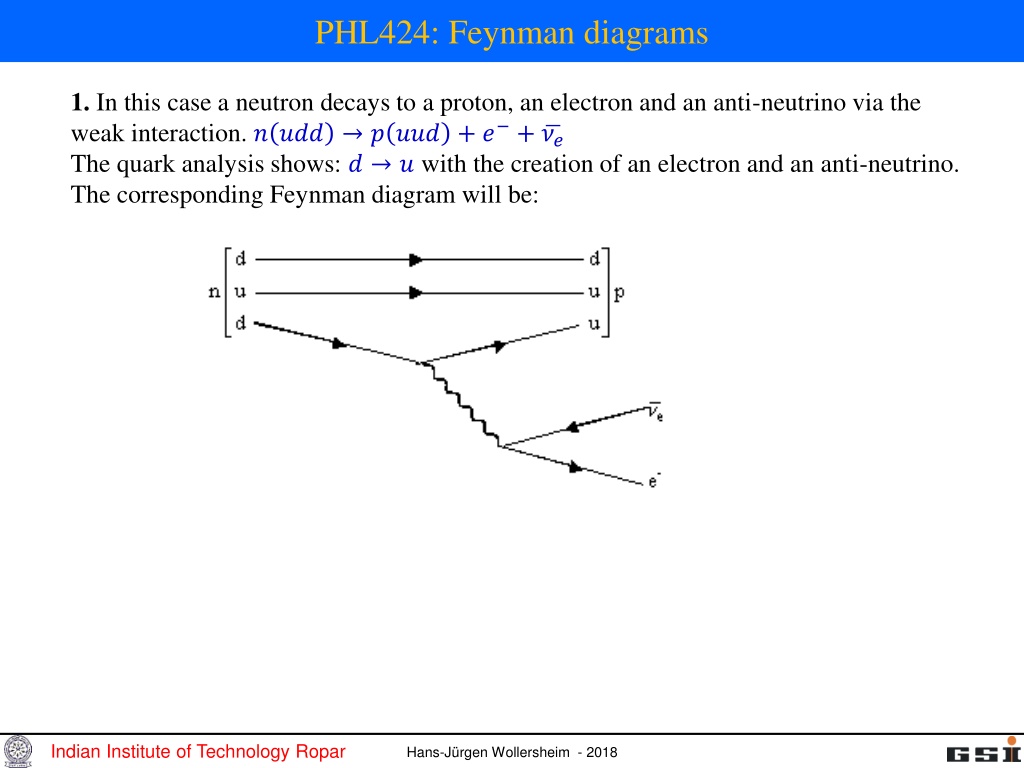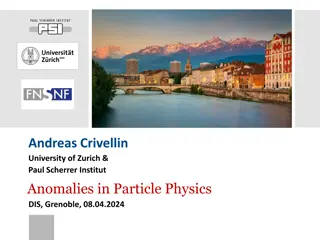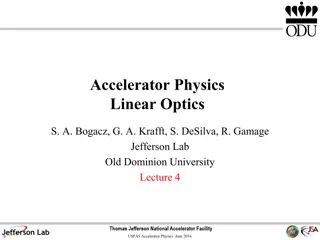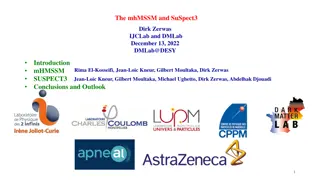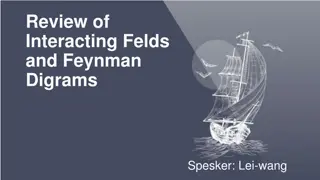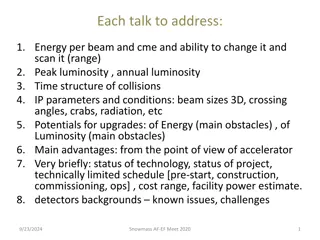Understanding Feynman Diagrams in Particle Physics
Exploring the concept of Feynman diagrams in particle physics through various examples, such as the decay of particles like neutrons, protons, electrons, anti-neutrinos, pi-mesons, and more. The diagrams illustrate the interactions between quarks and leptons, showcasing the transformations and decay processes in the subatomic world.
Download Presentation

Please find below an Image/Link to download the presentation.
The content on the website is provided AS IS for your information and personal use only. It may not be sold, licensed, or shared on other websites without obtaining consent from the author. Download presentation by click this link. If you encounter any issues during the download, it is possible that the publisher has removed the file from their server.
E N D
Presentation Transcript
PHL424: Feynman diagrams 1. In this case a neutron decays to a proton, an electron and an anti-neutrino via the weak interaction. ? ??? ? ??? + ? + ?? The quark analysis shows: ? ? with the creation of an electron and an anti-neutrino. The corresponding Feynman diagram will be: Indian Institute of Technology Ropar Hans-J rgen Wollersheim - 2018
PHL424: Feynman diagrams 2. In this example ?+ ?++ ??the up and the anti-down quarks in the pi-minus annihilate to produce a W+. The W+then materializes the lepton anti-lepton pair. ?+ ?? The Feynman diagram is a simple combination of a quark weak vertex and a lepton- weak vertex. The quarks come form the same generation. Similarly, the leptons are a first generation pair. Indian Institute of Technology Ropar Hans-J rgen Wollersheim - 2018
PHL424: Feynman diagrams 3. In this example ?+ ?++ ??+ ??the positive muon emits a W+and transforms to a muon ant-neutrino. The W+then materializes a lepton - anti-lepton pair from the first generation of the anti-lepton family. Indian Institute of Technology Ropar Hans-J rgen Wollersheim - 2018
PHL424: Feynman diagrams 4. In this case ?0? ? ?++ ? a Kaon-zero decays to a pi-plus and pi-minus via weak interaction. The quark analysis shows: ? ? with the creation of an anti-down up pair. This is a weak decay of the anti-strange quark. It is an allowed diagonal change between anti-quark generations. The Feynman diagram shows a combination of an antiquark-weak vertex and a quark-weak vertex. Indian Institute of Technology Ropar Hans-J rgen Wollersheim - 2018
PHL424: Feynman diagrams 5. In this case 0 ? + ? a lambda zero decays to a proton and a pi-minus via the weak interaction. The quark analysis shows: ? ? with the creation of a down anti- up pair. The corresponding Feynman diagram will be: This is a weak decay of the strange quark. It is an allowed diagonal change between quark generations. The Feynman diagram for the s to u transition is a combination of two quark-W vertices. The pion is derived from a same generation quark weak vertex Indian Institute of Technology Ropar Hans-J rgen Wollersheim - 2018
PHL424: Feynman diagrams 6. In this case + ? + ?0a Sigma plus decays to a proton and a pi-zero via the weak interaction. The quark analysis shows: ? ? with the creation of a down anti- up pair. The corresponding Feynman diagram will be: This is a weak decay of the strange quark. It is an allowed diagonal change between quark generations. The Feynman diagram for the s to u transition is a combination of two quark-W vertices. Indian Institute of Technology Ropar Hans-J rgen Wollersheim - 2018
PHL424: Feynman diagrams 7. In this case ?++ ? ? + ? a positron and an electron is annihilated. The electron emits a real photon and becomes a virtual electron. This virtual electron then annihilates with the positron with the emission further photon. It is a combination of two electromagnetic-lepton vertices. Indian Institute of Technology Ropar Hans-J rgen Wollersheim - 2018
PHL424: Feynman diagrams 8. In this case 0 0+ ?0a xi-zero (uss) decays into a lambda zero (uds) and a pi zero ? ? . The quark analysis shows: s ? with the creation of a down anti-up pair. The corresponding Feynman diagram will be: This is a weak decay of the strange quark. It is an allowed diagonal change between quark generation: We also can see a quark weak vertex leading to a anti-up and a down quark. This event involves only neutral particles and you may think that it could never be "seen" in a bubble chamber picture. BUT... The signaled tracks in the picture above shows the xi zero decay, in the bubble chamber picture of the discovery of omega minus! The two gammas come from pi zero disintegration! Indian Institute of Technology Ropar Hans-J rgen Wollersheim - 2018
PHL424: Feynman diagrams 9. In this case ?+ ?++ ?++ ? a kaon-plus decays to a pi-minus and two pi-plus via the weak interaction and a gluon. The quark analysis shows: ? ? and a W+ This is a weak interaction of the anti-strange quark to an anti-up quark with the creation of a W-plus. The W-plus decays and an anti-down quark and an up quark are created. A gluon is created and materializes a down quark and an anti-down quark. The anti-strange to anti-up vertex is an allowed diagonal change between anti-quark generations. Indian Institute of Technology Ropar Hans-J rgen Wollersheim - 2018
PHL424: Feynman diagrams 10. In this case 0 0+ ? one of the quarks in the sigma-zero emits a photon. It is a simple electromagnetic vertex. Indian Institute of Technology Ropar Hans-J rgen Wollersheim - 2018
PHL424: Feynman diagrams 11. In this case 0+ ? a omega minus (sss) decays into a xsi zero (uss) and a pi minus. The quark analysis shows: ? ? with the creation of a down anti-up pair. The corresponding Feynman diagram will be: This is a weak decay of the strange quark. It is an allowed diagonal change between quark generation: We also can see a quark weak vertex leading to a anti-up and a down quark. Indian Institute of Technology Ropar Hans-J rgen Wollersheim - 2018
PHL424: Feynman diagrams 12. In this case ?++ ? ?0+ ++there is a collision between a positive kaon (K+) and a proton (p) In the strong interaction a neutral kaon (K0) and an excited state ( ++) are produced. The ++then decays to a proton and a positive pion. The suggested Feynman diagram might be: This is a strong interaction and involves quark-gluon vertices only. The quark analysis shows the up quark of the kaon emits a gluon and the gluon materializes into a down quark and an anti-down quark. The down quark of the proton annihilates with the anti-down quark emitting a gluon. The three up quarks recombine as an excited state ++. Then an up quark of the excited state emits a gluon and the gluon materializes into a down quark and an anti-down quark. An up quark and the anti-down quark recombine as a positive pion. Two up and the down quark recombine as a proton. Indian Institute of Technology Ropar Hans-J rgen Wollersheim - 2018
PHL424: Feynman diagrams 13. In this case ? + ? ? + ? there is a collision between a proton (p) and an antiproton ( ?). In the final state a neutron and an anti-neutron are produced. The quark analysis shows: The anti-up quark of the anti-proton annihilates with the up quark of the proton emitting a gluon. The anti-down quark of the antiproton emits a gluon and the gluon materialize into an anti-down and a down quark. The corresponding Feynman diagram will be: This is a strong interaction and involves quark-gluon vertices only. Indian Institute of Technology Ropar Hans-J rgen Wollersheim - 2018
PHL424: Feynman diagrams 14. In this case 0+ ? + ??an Omega minus decays to a xi- zero, an electron and electron anti-neutrino via the weak interaction. The quark analysis shows: ? ? with the creation of an electron - antineutrino pair. The corresponding Feynman diagram will be: This is a weak decay of the strange quark. It is an allowed diagonal change between quark generations. The Feynman diagram illustrates that the reaction is a combination of a quark weak vertex and a weak-lepton vertex. Indian Institute of Technology Ropar Hans-J rgen Wollersheim - 2018
